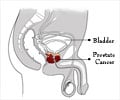New research which investigated ways of treating side effects of therapy for prostate cancer has made a new finding.

Testosterone can drive the growth of prostate cancer and anti-androgens are used to inhibit prostate cancer growth by preventing testosterone from binding to androgen receptors. But receptors in cells within the testes are also blocked and start to make more testosterone to compensate. Some of this extra testosterone is converted into estrogen which is responsible for development of breast tissue and other breast events. Anti-estrogens work by jamming the estrogen receptor, while aromatase inhibitors prevent the conversion of testosterone into estrogen.
A collaboration between the German Cochrane Center and University Clinic Erlangen combined data from four independent clinical trials each looking at the management of breast events (during treatment for prostate cancer) with tamoxifen.
A meta-analysis of all four trials showed that tamoxifen reduced the risk of both gynecomastia and breast pain at 3, 6, 9, and 12 months of treatment compared to men who received no treatment. Overall, treatment with tamoxifen was more successful in reducing breast symptoms than treatment with an aromatase inhibitor (anastrazole) or radiotherapy.
Although there is no long term data available, few of the men treated with tamoxifen, either as preventative or therapeutic treatment, stopped taking their medication during their year of treatment. There were also no significant adverse effects.
Dr Frank Kunath, who led this study explained, "Not all men will suffer gynecomastia during anti-androgen therapy. However, if men know that there is a successful option for reducing the breast symptoms associated with treatment for prostate cancer they may be more likely to see their doctor when symptoms of cancer first appear, and consequently reduce the number of unnecessary deaths."
Advertisement



![Prostate Specific Antigen [PSA] & Prostate Cancer Diagnosis Prostate Specific Antigen [PSA] & Prostate Cancer Diagnosis](https://images.medindia.net/patientinfo/120_100/prostate-specific-antigen.jpg)






